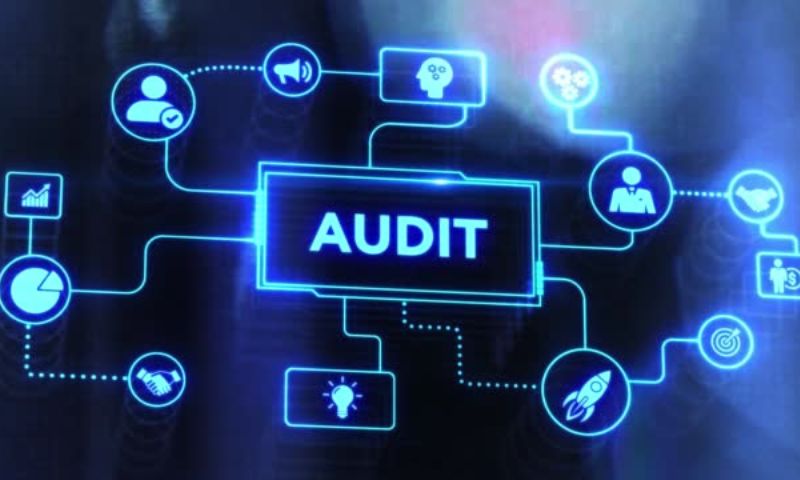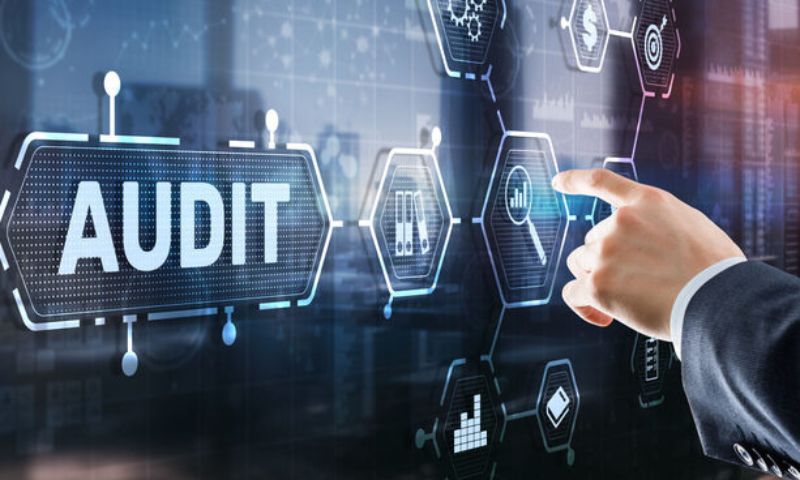Imagine your blockchain is a digital fortress. To keep it safe from invaders—hackers who can sneak in and wreak havoc—you need an armor-clad plan. That’s where the process of a security audit for blockchains comes in. It’s not just about checking boxes; it’s a deep dive into the very core of your blockchain to find and fix weaknesses before they’re exploited. You need to know the ins and outs of this essential safeguard, and I’m here to guide you through every step, ensuring your digital ledger remains unbreakable. Let’s break down the blocks and fortify your blockchain!
Understanding the Stakes: The Need for Blockchain Security Auditing
The Role of Auditing in Blockchain Integrity
You own some crypto. You love how it’s safer than holding cash. You hear words like “blockchain” and “security.” But what keeps your digital money safe? Auditing is the hero here.
Imagine your blockchain as a bank vault. Auditing is like the best guard ever, always checking for weak spots. It’s a deep look at the blockchain’s safety systems. We check every part: the tech, the rules, and the code. Because in blockchains, each block links to the next by a chain of trust. If one link breaks, trouble hits everyone.
People like me, security auditors, are trained to spot where bad things might happen. We are the detectives. We make sure bad guys have a hard time messing with the blockchain. We do stuff like crack puzzles and read loads of code. Our main job? Find problems before bad guys do.
We run tests, kind of like an intense doctor’s check-up but for crypto stuff! We give blockchains a clean bill of health, or we fix what’s wrong. This way, you can sleep easy, your crypto safe and sound.
Exploring Smart Contract Vulnerabilities
Now, let’s chat about smart contracts. They’re like vending machines. You pick what you want, pay up, and bam, you get what you asked for—no need for anyone to help you. But what if someone shakes the vending machine to get free stuff? That’s a loophole—a smart contract vulnerability.
Smart contracts are bits of code. They make deals happen on blockchain without the need for a middleman. But code can have mistakes, and mistakes can mean stolen crypto. So, we have to check them line by line. That’s what we call a code review—a super detailed read-through.
We use special checklists to get every piece of code right. It’s a detective game—looking for tiny errors that could cause big trouble. By finding these before troublemakers do, we shut down their attempts to take what’s not theirs.
Sometimes, I wear my hacker hat and think like the bad guys—this is penetration testing. I attack the blockchain like they would. Why? So I can find and fix weak spots first. Plus, I also check how the blockchain talks to other ones—that’s auditing cross-chain transactions. It helps stop sneaks from slipping through the gaps.
In the end, what’s this all for? To make sure your digital coins stay yours. It helps keep the big, exciting world of crypto spinning—safe, sound, and foolproof! And believe me, in blockchain land, staying one step ahead is the key to keeping your digital treasure chest locked tight.
Diving Deep: The Blockchain Security Audit Process
Conducting Thorough Code Review in Blockchain Systems
Let’s talk about keeping blockchains safe. A big part is checking the code. It’s like proofreading but for tech. Smart folks pore over blockchain code. They hunt for things that seem off. We call these things smart contract vulnerabilities. They’re like cracks in a wall where trouble can slip through. This stage involves a lot of peering at screens and thinking hard.
We check every line to catch sneaky bugs and glitches. Miss one, and a hacker might get in. It’s like a game of hide and seek with stakes sky-high. Think of your digital assets as gold in a vault. Code review is making sure the vault’s lock is a tough nut to crack.
Utilizing Penetration Testing and Decentralized Ledger Security Checks
Next up is breaking into our own system. Sounds wild, right? This is called penetration testing for DLT. Experts act like cyber crooks, trying to bust into the blockchain. If they can worm their way in, we’ve got work to do. It’s a test to make the real deal tough as nails.
We do checks, too, on the ledger that’s all spread out. Each node, or connection point, has to be snug as a bug in a rug. It’s all about making sure there’s no open window for a sneaky break-in. And guess what? This happens a lot. More than you’d think.
The goal is clear: no weak spots. Not one. Our job is to seal up the blockchain good and tight. Think of it as wrapping your treasure in the strongest armor out there. It’s about peace of mind that your stuff is safe.
So, that’s how we keep blockchains secure. Code review, looking for slip-ups. Penetration tests, to beat hackers at their own game. And in the end, a blockchain that’s as sturdy as a fortress. With these checks, we sleep easy, knowing the digital treasure is locked down tight.
Methodical Approach: Risk Analysis and Rectifying Security Issues
Evaluating Consensus Mechanisms and Node Security
When I look at a blockchain, I first check the heartbeat — its consensus mechanism. This is the system that keeps all users honest. Is it proof of work, proof of stake, or another method? I need to know. I ask, can someone control over half of it? That’s bad. It could let them harm the system. I test to see how the system defends against this. I also look at the nodes, each computer in the network. Each must be safe, like a vault. I make sure they are tough and follow the rules.
I then dig deeper into node security. Each node holds a piece of the puzzle. So, each must be a fortress. I test the walls and gates. I check for holes and patch them up. I need to keep the bad guys out. My tool belt is full of blockchain audit tools. They help me look into each node. If I find a crack, I fix it real fast.
Identifying and Addressing Blockchain Security Flaws
Next up: finding the flaws. Blockchain is tough, but not unbreakable. I look for weak spots in the code. Smart contract bugs can creep in and bite hard. I use my eyes and tools to find them. Then I use the smart contract audit process to squash them flat. It’s like a game of hide-and-seek with a high score of safety.
Sometimes the flaws are small. Sometimes they need a big fix. It can be like finding a needle in a haystack. But when I do, I pull it out. I always keep an audit checklist handy. It keeps me on track. It’s the map that leads to treasure: a secure blockchain.
Each blockchain has its own rules, the security protocols. These keep every crypto platform in line. I check these. I compare them to the best practices out there. I’m not just a watchdog. I’m a coach. I help them get stronger, run faster, be better.
And when something new comes up, like cross-chain transactions, I’m on it. They bring new risks, so I bring new solutions. I make sure nothing sneaky gets through from one chain to the next.
My goal is clear: Keep everyone’s digital treasure safe. I hunt down problems and fix them. I prevent the 51% attack, the big bad wolf of blockchain. And when I’m done, I write it all down in a security audit report. It’s the story of how I made the blockchain a safer place. If trouble comes knocking, the blockchain will be ready, with an incident response plan.
I don’t just find problems and leave. I help fix them. I update security. I test everything again. It’s a loop that keeps going, spinning toward safety. And I’m always learning, staying ahead of the tricks of the trade.
In this world of codes and keys, my job is to be the guardian. From evaluation to rectification, I make sure the digital ledger stays tough. That’s how we build trust in this land of blockchain.
Ensuring Compliance and Enforcing Security Measures
The Importance of Regulatory Frameworks in Blockchain Auditing
Sticking to rules is a must in blockchain auditing. These rules, or laws, help us make sure everything in the blockchain is fair and safe. When we do a blockchain audit, we have to check many things to see if they follow the rules. This process is what keeps your digital money and transactions secure.
Why does this matter? Well, think of the blockchain as a game where players are all over the world. The rules of the game make sure no one cheats and everyone can trust the game. In blockchain, these rules are about your money and data, so they’re super important!
Crafting a Comprehensive Blockchain Security Audit Report
Hey there! Let’s chat about making a top-notch security report for your blockchain. First off, I dive in and peek at every corner of your blockchain’s code. I call this a code review. It’s like being a detective for computer code, looking for any clues that something might go wrong.
After that, it’s go-time for some tough love called penetration testing, or pen testing for short. This is a cool way to test the blockchain, kinda like checking if a lock on your door is strong enough. It shows if someone can sneak in and mess with your blockchain.
What comes next? We need to jot down our findings in a report. This report talks about all the bits we found, good and bad. If we spot something wonky, like a weak spot in smart contracts, we make a note. This helps us plan out how to fix it afterward.
So there you have it! These steps are like a health check-up but for blockchains. They keep your digital dollars safe, and make sure everything plays nice and follows the rules. Remember, it’s all about trust. And with a strong shield of security wrapped around your blockchain, you can sleep soundly at night.
In this article, we dove into why blockchain security audits are key to safe tech. We saw how audits keep blockchain honest and smart contracts strong against attacks. We then walked through the audit steps, from deep code checks to testing for weak spots. We learned how looking at risks can help fix security bugs and keep each part secure. Plus, we can’t forget how rules guide audits and help write full reports that make sense. To wrap up, doing blockchain security audits right means we stop trouble before it starts. It’s about keeping our tech safe and trusty for everyone. Keep it strong, keep it safe!
Q&A :
How is a security audit for a blockchain performed?
A blockchain security audit involves a systematic evaluation of the entire blockchain system, aiming to uncover vulnerabilities and ensure the integrity of the network. The process begins with a review of the system’s architecture and its smart contract code. Auditors conduct both automated and manual assessments to detect potential security weaknesses. They also simulate attacks to identify breach points within the system. Upon completion, the security team generates a report outlining the findings and recommendations for patching discovered vulnerabilities.
What are the key components checked during a blockchain security audit?
During a blockchain security audit, several key components are scrutinized for potential security risks. These include the smart contract code, which governs the rules and behaviors of the blockchain interactions; the network’s consensus algorithms; the backend and frontend systems that interface with the blockchain; access controls and authentication mechanisms; and the data storage practices. Auditors will ensure that all these components adhere to best security practices to maintain a robust and secure blockchain ecosystem.
Why are security audits critical for blockchain systems?
Security audits are critical for blockchain systems because they help to fortify the network against security breaches, which are especially damaging given the immutable nature of blockchains. Since blockchains often involve financial transactions or sensitive data, a breach can result in significant monetary losses or privacy violations. Regular security audits allow developers to detect and fix security flaws, maintain user trust, protect investments and ensure that the system complies with any relevant regulatory standards.
How often should a blockchain undergo a security audit?
The frequency at which a blockchain should undergo a security audit can vary based on multiple factors, such as the size of the network, the volume and type of transactions processed, and the complexity of the smart contracts. However, it is generally recommended that a blockchain system be audited regularly, such as annually, as well as any time there are significant changes to the code or the network’s infrastructure. Continuous monitoring for emergent threats is also advisable to maintain ongoing security.
What can be done to ensure the effectiveness of a blockchain security audit?
To ensure the effectiveness of a blockchain security audit, it’s important to employ a comprehensive audit approach. This can include selecting a reputable auditing firm with blockchain expertise, providing full access to system documentation, engaging in threat modeling, and conducting both static and dynamic analysis of the code. It’s also crucial to implement the recommendations resulting from the audit and establish a routine for regular security assessments. Continuous training and staying up to date with the latest security trends can further enhance the security posture of a blockchain system.


